Ladakh, often referred to as the “Land of High Passes,” is a mesmerizing region located in the northernmost part of India. This unique destination, characterized by its breathtaking landscapes, rich Indian cultural heritage, and adventure-filled activities, has become increasingly popular among travelers seeking both tranquility and thrill. In this extensive article, we will delve into the geographical, historical, cultural, and adventurous aspects of Ladakh, providing a comprehensive guide for anyone looking to explore this enchanting land.
Ladakh Population
Ladakh, a Union Territory of India, has a diverse population of approximately 274,289 people, as per the 2011 census. The region is predominantly inhabited by Ladakhis, with significant Tibetan and Balti communities contributing to its rich cultural tapestry. Buddhism is the main religion, particularly Tibetan Buddhism, while Islam, primarily among the Balti and Shia communities in Kargil, also plays a vital role in the local culture. The primary language spoken is Ladakhi, alongside Tibetan and Balti, with Urdu, Hindi, and English commonly used for communication, especially in urban areas like Leh and Kargil. The population is largely rural, reflecting a close-knit community life shaped by the harsh yet beautiful high-altitude environment, where traditions and customs are deeply rooted in the region’s history. As Ladakh continues to evolve, understanding its demographic dynamics is essential for fostering sustainable development and cultural preservation.

Geographic Overview
Location and Borders
Ladakh is situated in the northernmost region of India, sharing its borders with Pakistan to the west, China to the north and east, and the Indian state of Jammu and Kashmir to the south. The region primarily falls within the Union Territory of Ladakh, which was established in October 2019 following the abrogation of Article 370 of the Indian Constitution. This political change has led to increased interest in the region as a travel destination.
Topography
The geography of Ladakh is dominated by high-altitude mountain ranges, deep valleys, and vast expanses of desert. The major mountain ranges include the Himalayas to the south and the Karakoram range to the north. The region’s average elevation is around 3,000 meters (9,800 feet) above sea level, making it one of the highest inhabited regions in the world.
Ladakh features stark contrasts in its landscapes, from snow-capped mountains and glacial lakes to arid desert terrain. The unique topography creates stunning vistas that are a photographer’s dream. The region is also home to several high-altitude lakes, such as Pangong Tso and Tso Moriri, known for their striking colors and serene surroundings.
Climate
Ladakh temperature experiences a cold desert climate, characterized by long, harsh winters and short, mild summers. Winter temperatures can plunge to -30°C (-22°F), while summer temperatures can soar up to 30°C (86°F). The best time to visit Ladakh is between May and September, when the weather is pleasant, and most roads and attractions are accessible. During winter, the region transforms into a snowy wonderland, attracting adventure seekers for activities like skiing and trekking on the frozen Zanskar River.
Rivers and Lakes
The Indus River is the primary river flowing through Ladakh, originating from the Tibetan plateau and traversing the region before entering Pakistan. Other important rivers include the Zanskar and Shyok rivers, which offer thrilling white-water rafting opportunities.
Ladakh is renowned for its high-altitude lakes, which are among the most beautiful in the world. Notable lakes include:
- Pangong Tso: Stretching approximately 134 kilometers, this lake is famous for its stunning blue waters that change color throughout the day. About 60% of its length lies in China, making it a subject of geopolitical interest.
- Tso Moriri: Located at an altitude of about 4,595 meters (15,075 feet), Tso Moriri is another breathtaking lake surrounded by snow-capped mountains. It is known for its unique ecosystem and is a designated Ramsar Wetland site.
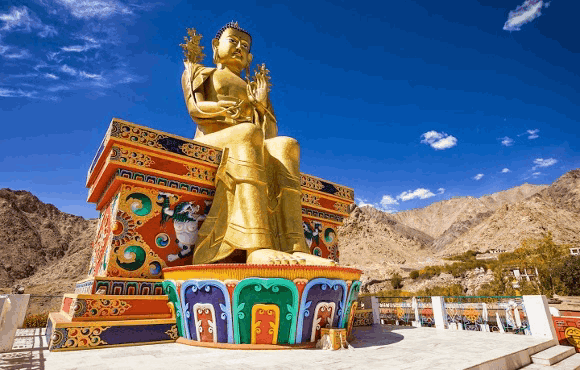
History of Ladakh
Ancient History
Ladakh’s history dates back to ancient times, when it was an important stop along the Silk Route, facilitating trade between India, Tibet, and Central Asia. This historical significance has shaped the region’s cultural and economic landscape, influencing everything from language to cuisine.
The strategic location of Ladakh has made it a melting pot of various cultures and traditions, as it has seen the passage of numerous traders, pilgrims, and travelers over the centuries.
The Influence of Buddhism
Buddhism arrived in Ladakh around the 7th century and has since become the predominant religion in the region. The arrival of Buddhism led to the establishment of numerous monasteries, known as gompas, which serve as centers of spiritual life and education. These monasteries are not only places of worship but also repositories of art, culture, and history.
Modern History
In the 19th century, Ladakh came under the rule of the Dogra Empire and later joined the Indian Union in 1947. The geopolitical significance of Ladakh has grown in recent decades due to its strategic location, leading to increased military presence and political interest in the region. In 2019, the establishment of Ladakh as a Union Territory marked a new chapter in its political landscape, offering opportunities for development and tourism.
Cultural and Heritage site of Ladakh
Ethnic Diversity
Ladakh is home to a diverse population composed of various ethnic groups, including Ladakhis, Tibetans, and Balti people. Each community possesses its own unique traditions, customs, and languages, contributing to the rich cultural tapestry of the region. The people of Ladakh are known for their warmth and hospitality, making visitors feel welcome.
Language
The primary language spoken in Ladakh is Ladakhi, which belongs to the Tibetic language family. Other languages, such as Urdu, Hindi, and English, are also widely spoken, especially in urban areas and tourist destinations. The linguistic diversity reflects the region’s historical interactions with neighboring cultures.
Festivals
Ladakh is known for its vibrant festivals that showcase its rich cultural heritage. Some of the most significant festivals include:
- Hemis Festival: Celebrated at Hemis Monastery, this annual festival features colorful masked dances and spiritual rituals honoring Guru Padmasambhava. It typically takes place in June or July and attracts thousands of visitors.
- Losar: The Tibetan New Year is celebrated with great enthusiasm, marked by feasting, dancing, and traditional games. It is a time for families to come together and celebrate their cultural identity.
- Ladakh Festival: Held in September, this festival highlights local arts, crafts, music, and dance, showcasing the region’s rich cultural heritage. It attracts tourists and locals alike, promoting community spirit and cultural exchange.
Cuisine
Ladakhi cuisine is heavily influenced by Tibetan flavors, characterized by hearty and warming dishes. Key highlights include:
- Thukpa: A nourishing noodle soup that is a staple during the colder months, often made with vegetables or meat.
- Momos: Steamed dumplings filled with vegetables or meat, perfect for a quick snack. Momos are a popular street food item in Ladakh.
- Butter Tea (Chai): A unique beverage made from tea, butter, and salt, popular among locals, especially in winter.
Major Attractions
Monasteries and Gompas
Ladakh is renowned for its ancient monasteries, which are architectural marvels and centers of spiritual life. Some of the most notable gompas include:
- Hemis Monastery: The largest and wealthiest monastery in Ladakh, famous for its annual Hemis Festival. The monastery houses a vast collection of ancient artifacts, including statues and thangkas, and is an important pilgrimage site.
- Thiksey Monastery: This stunning monastery resembles the Potala Palace in Lhasa and offers breathtaking views of the Indus Valley. It features a beautiful statue of the Maitreya Buddha and several shrines adorned with intricate murals.
- Diskit Monastery: Located in Nubra Valley, Diskit Monastery is known for its massive statue of Maitreya Buddha, which overlooks the valley. The monastery is an important center for Buddhist learning and meditation.
Natural Wonders of Ladakh trip
Ladakh is blessed with unparalleled natural beauty. Some must-visit locations include:
- Pangong Lake: Famous for its mesmerizing blue waters that change color throughout the day, this high-altitude lake is a photographer’s paradise. Visitors can enjoy boating, photography, and peaceful walks along the shore.
- Nubra Valley: Known for its sand dunes and unique double-humped camels, Nubra offers a different side of Ladakh’s landscape. The valley is accessible via the Khardung La Pass, one of the highest motorable roads in the world.
- Tso Moriri Lake: A stunning high-altitude lake surrounded by mountains, Tso Moriri is known for its unique ecosystem and breathtaking views. It is a UNESCO Ramsar Wetland site, attracting birdwatchers and nature enthusiasts.
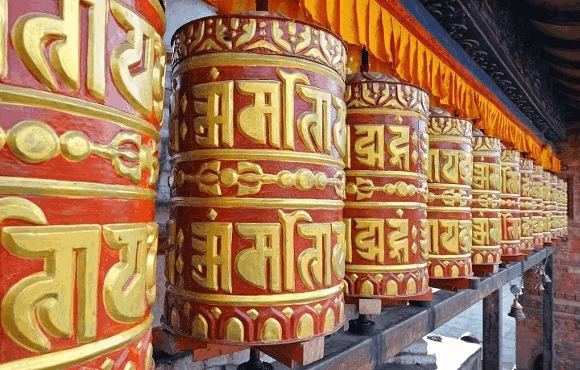
Historical Sites
Ladakh is rich in historical sites that tell the story of its past. Notable sites include:
- Leh Palace: An ancient royal palace that offers panoramic views of Leh and is an excellent example of traditional Ladakhi architecture. The palace is a reminder of the region’s rich history and royal heritage.
- Shanti Stupa: A white-domed stupa built to promote peace and harmony, Shanti Stupa provides stunning views of the surrounding mountains and valleys. It is a popular spot for meditation and photography.
River Rafting
The Zanskar River offers exhilarating white-water rafting experiences, attracting adventure lovers from around the world. The river’s rapids provide both excitement and scenic beauty, making it a popular activity during the summer months.
Mountain Biking
Ladakh’s rugged terrain and breathtaking landscapes make it a perfect destination for mountain biking. Cyclists can explore scenic routes that offer breathtaking views of the mountains, valleys, and monasteries.
Wildlife Safari
Ladakh is home to diverse wildlife, including the elusive snow leopard, Tibetan antelope, and various bird species. Exploring national parks like Hemis National Park can provide incredible wildlife viewing opportunities.
Travel Tips
Best Time to Visit
The ideal time to visit Ladakh is from May to September when the weather is pleasant, and most roads and attractions are accessible. Winter offers a different experience with snow-covered landscapes and winter sports, but travel can be challenging due to harsh weather conditions.
Getting There
Ladakh can be reached by air or road. The Kushok Bakula Rimpochee Airport in Leh is well-connected to major cities like Delhi and Srinagar. For road trips, the Leh-Manali and Leh-Srinagar highways offer breathtaking views but require careful driving due to high altitudes.
Acclimatization
Due to its high altitude, acclimatization is essential. Spend the first few days in Leh to allow your body to adjust before engaging in strenuous activities. It’s advisable to drink plenty of water and avoid excessive physical exertion during the first few days.
Health and Safety
Travelers should carry essential medications, stay hydrated, and be cautious of altitude sickness. It’s advisable to have travel insurance that covers high-altitude activities. Additionally, travelers should be mindful of local health facilities and emergency contacts.
Cultural Sensitivity
Visitors should respect local customs and traditions. Dress modestly, especially when visiting religious sites, and be mindful of cultural practices. Engaging with locals in a respectful manner can enhance your travel experience.
In-Depth Exploration of Key Attractions
Hemis Monastery
Hemis Monastery, located about 45 kilometers from Leh, is one of the largest and wealthiest monasteries in Ladakh. It is known for its annual Hemis Festival, celebrated in June or July, which attracts thousands of visitors. The monastery houses a vast collection of ancient artifacts, including statues, thangkas, and scriptures. The architecture is a stunning example of traditional Ladakhi design, featuring beautiful murals and intricate carvings.
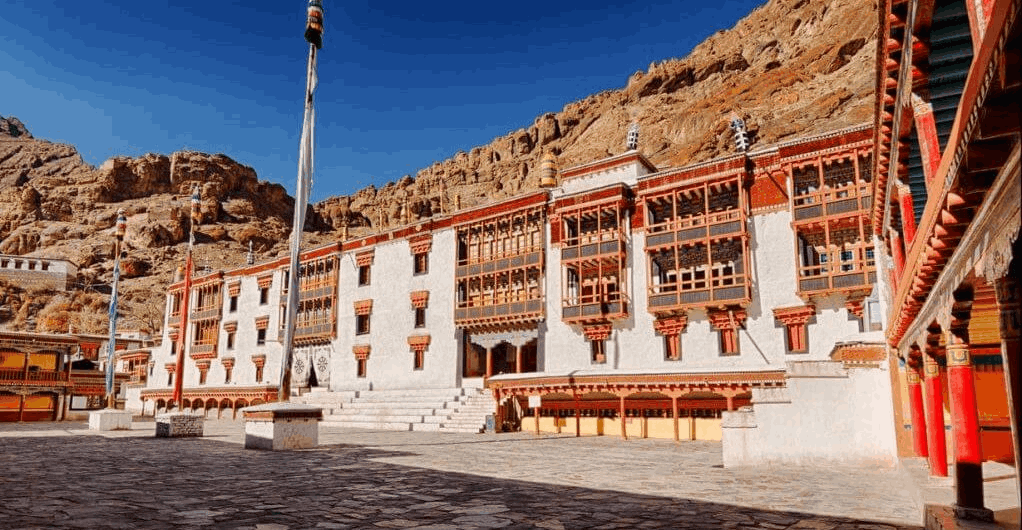
Pangong Lake
Pangong Lake is a breathtaking high-altitude lake that stretches approximately 134 kilometers, with about 60% of its length lying in China. The lake’s shimmering blue waters change colors throughout the day, creating a mesmerizing spectacle. Visitors can enjoy boating, photography, and peaceful walks along the shore. The stunning backdrop of the Himalayan mountains adds to the lake’s enchanting beauty.
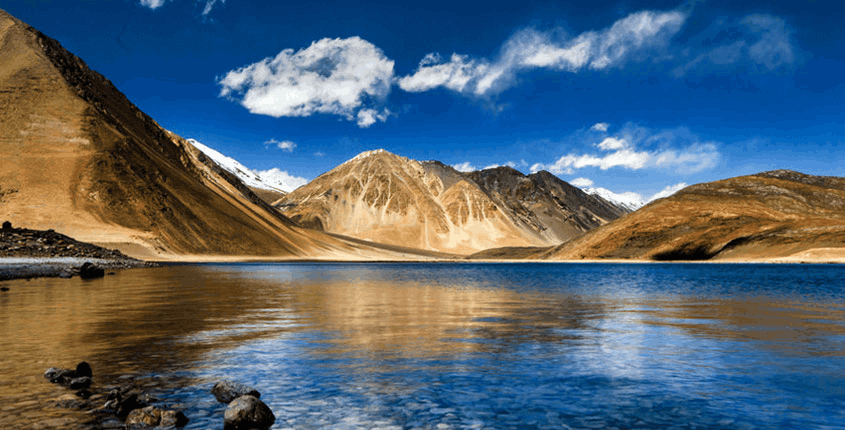
Nubra Valley in Ladakh
Nubra Valley, located north of Leh, is a unique destination characterized by its lush greenery, sand dunes, and double-humped camels. The valley is accessible via the Khardung La Pass, one of the highest motorable roads in the world. Key attractions in Nubra Valley include Diskit Monastery, known for its giant Buddha statue, and Hunder, famous for its sand dunes and Bactrian camels. The valley’s picturesque landscapes and tranquil ambiance make it a popular spot for relaxation and exploration.

Tso Moriri Lake in Ladakh
Tso Moriri Lake, situated at an elevation of about 4,595 meters (15,075 feet), is a stunning high-altitude lake surrounded by snow-capped mountains. The lake is a UNESCO Ramsar Wetland site and is known for its unique ecosystem, attracting a variety of migratory birds. Visitors can engage in birdwatching, photography, and camping around the lake. The serene environment and breathtaking views make Tso Moriri a must-visit destination in Ladakh.
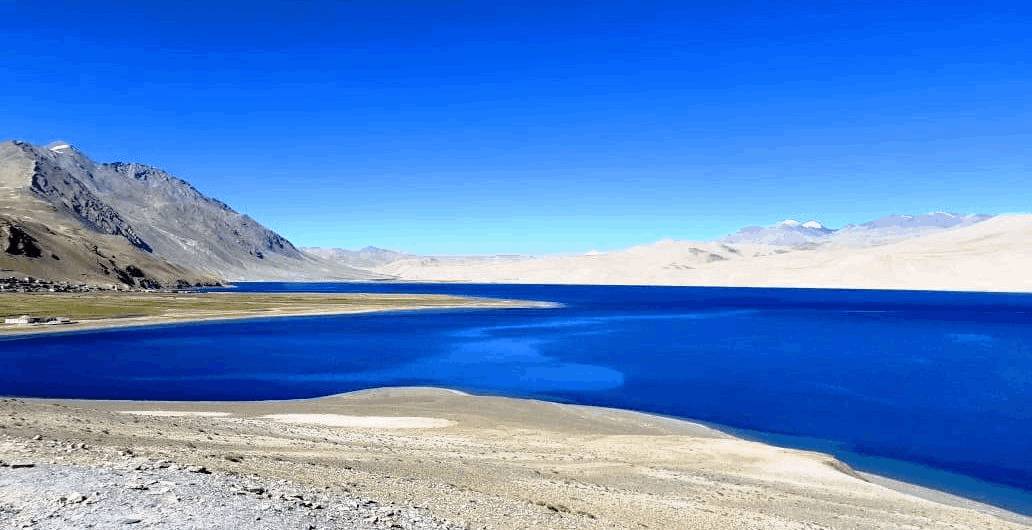
Leh Palace
Leh Palace, built in the 17th century, is a remarkable example of traditional Ladakhi architecture. The palace offers stunning panoramic views of Leh town and the surrounding mountains. Visitors can explore the ruins, which house several artifacts and murals that reflect the rich history of the region. The palace is an excellent spot for photography, especially during sunrise and sunset.
Ladakh Tour Package
Here’s a selection of popular Leh Ladakh tour packages, along with approximate prices and what each package typically includes. Prices can vary based on the season, group size, and specific inclusions.
Classic Leh Ladakh Trip Cost (5 Days)
Price: ₹25,000 – ₹35,000 per person
Inclusions:
- Accommodation (3-star hotels or guesthouses)
- Daily breakfast and dinner
- Transportation in a private vehicle
- Local sightseeing (Leh Palace, Shanti Stupa, Thiksey Monastery)
- Day trip to Pangong Lake
Sample Itinerary:
- Day 1: Arrival in Leh, acclimatization
- Day 2: Local sightseeing in Leh
- Day 3: Visit Pangong Lake
- Day 4: Nubra Valley excursion
- Day 5: Departure
Adventure Tour Package of Ladakh (7 Days)
Price: ₹35,000 – ₹50,000 per person
Inclusions:
- Accommodation (3-star hotels and camps)
- Meals (breakfast, lunch, and dinner)
- Transportation
- Trekking permits and guides
- Activities (rafting, trekking)
Sample Itinerary:
- Day 1: Arrival in Leh, acclimatization
- Day 2: Local sightseeing
- Day 3: Begin Markha Valley Trek
- Day 4-5: Continue trekking
- Day 6: River rafting in Zanskar
- Day 7: Departure
Cultural Tour Package (6 Days)
Price: ₹30,000 – ₹45,000 per person
Inclusions:
- Accommodation in homestays or guesthouses
- Meals (breakfast and dinner)
- Cultural workshops (cooking, crafts)
- Transportation
Sample Itinerary:
- Day 1: Arrival in Leh
- Day 2: Visit monasteries and participate in local workshops
- Day 3: Attend a local festival (if available)
- Day 4: Community engagement activities
- Day 5: Visit Nubra Valley
- Day 6: Departure
Family Package (7 Days)
Price: ₹40,000 – ₹55,000 for a family of four
Inclusions:
- Accommodation (family-friendly hotels)
- Meals (breakfast and dinner)
- Transportation
- Sightseeing and activities suitable for families
Sample Itinerary:
- Day 1: Arrival in Leh, acclimatization
- Day 2: Local attractions
- Day 3: Visit Pangong Lake
- Day 4: Nubra Valley visit
- Day 5: Day at leisure (family activities)
- Day 6: Cultural experiences
- Day 7: Departure
Customizable Package of Leh Ladakh
Price: Varies based on customization (starting from ₹20,000 per person)
Inclusions:
- Tailored itinerary
- Accommodation choices
- Activities of your preference (trekking, biking, cultural experiences)
- Transport arrangements
Notes on Pricing:
- Seasonality: Prices are generally higher during peak tourist months (June to August).
- Group Discounts: Many agencies offer discounts for larger groups.
- Booking in Advance: Early bookings often lead to better prices and availability.
- Inclusions: Always check what’s included in the package (transport, meals, permits).
Adventure Activities in Detail
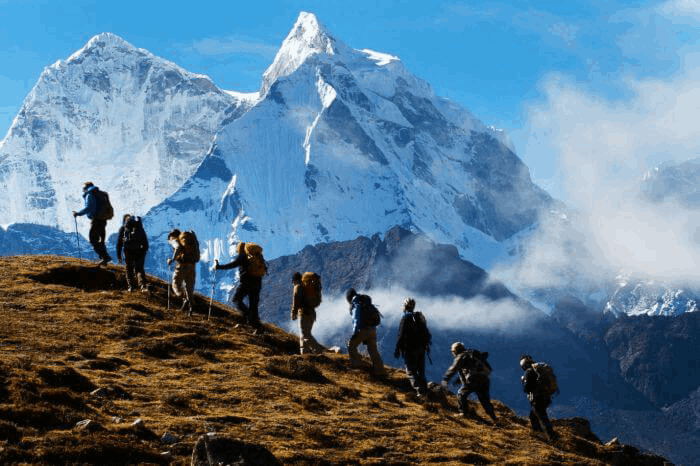
Trekking Trails in Ladakh
Ladakh is renowned for its trekking opportunities, catering to both beginners and experienced trekkers. Some popular trekking routes include:
- Markha Valley Trek: A moderately difficult trek that takes you through picturesque landscapes, traditional villages, and ancient monasteries. The trek typically lasts around 8 days and provides an opportunity to experience local culture.
- Stok Kangri Trek: This challenging trek leads to the summit of Stok Kangri, a popular peak for climbers. The trek offers stunning views of the surrounding mountains and valleys.
- Chadar Trek: This unique trek along the frozen Zanskar River during winter is a once-in-a-lifetime experience for adventure seekers. It offers stunning views of ice formations and snow-covered landscapes.
Mountain Biking of Leh Ladakh
The rugged terrain of Ladakh is ideal for mountain biking. Cyclists can explore scenic routes that offer breathtaking views of the mountains, valleys, and monasteries. The Leh-Manali highway is a popular route for biking enthusiasts, providing an exhilarating experience amidst stunning landscapes.
Wildlife and Nature Tours in Ladakh
Ladakh’s unique ecosystem offers excellent opportunities for wildlife enthusiasts. Hemis National Park is home to the elusive snow leopard, Tibetan antelope, and various bird species. Guided wildlife tours allow visitors to explore the park’s diverse flora and fauna while learning about conservation efforts.
Ladakh Cultural Experiences
Ladakh is rich in culture, and visitors can engage in various cultural activities. Homestays in local villages provide an opportunity to experience traditional Ladakhi life, including cooking classes, handicraft workshops, and participation in local festivals. These experiences foster a deeper understanding of the region’s customs and traditions.
Conclusion
Ladakh is a captivating destination that offers a unique blend of natural beauty, rich cultural heritage, and adventure. Whether you’re exploring ancient monasteries, trekking through stunning landscapes, or savoring local delicacies, every moment in Ladakh is an experience to cherish. As you plan your journey to this enchanting region, remember to embrace its unique culture and breathtaking vistas, and ensure that your visit contributes positively to the local community.
Whether you’re an adventure seeker, a culture enthusiast, or simply looking for tranquility, Ladakh promises an unforgettable journey that will leave an indelible mark on your heart. So pack your bags and get ready to explore the magical land of Ladakh, where every turn reveals a new wonder!
